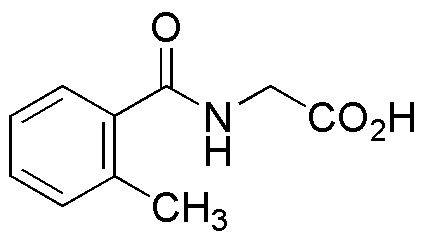2-Methylhippuric acid is widely utilized in research focused on:
- Biochemical Studies: It serves as a biomarker for toluene exposure, helping researchers assess environmental and occupational health risks.
- Pharmaceutical Development: This compound is used in the synthesis of various pharmaceuticals, contributing to the development of drugs with enhanced efficacy.
- Analytical Chemistry: It plays a role in chromatographic techniques, aiding in the separation and analysis of complex mixtures in laboratories.
- Cosmetic Formulations: The compound is incorporated into skincare products for its potential benefits in skin health, offering a natural alternative to synthetic additives.
- Environmental Monitoring: It is utilized in studies assessing the impact of industrial pollutants, providing insights into contamination levels and remediation strategies.
General Information
Properties
Safety and Regulations
Applications
2-Methylhippuric acid is widely utilized in research focused on:
- Biochemical Studies: It serves as a biomarker for toluene exposure, helping researchers assess environmental and occupational health risks.
- Pharmaceutical Development: This compound is used in the synthesis of various pharmaceuticals, contributing to the development of drugs with enhanced efficacy.
- Analytical Chemistry: It plays a role in chromatographic techniques, aiding in the separation and analysis of complex mixtures in laboratories.
- Cosmetic Formulations: The compound is incorporated into skincare products for its potential benefits in skin health, offering a natural alternative to synthetic additives.
- Environmental Monitoring: It is utilized in studies assessing the impact of industrial pollutants, providing insights into contamination levels and remediation strategies.
Documents
Safety Data Sheets (SDS)
The SDS provides comprehensive safety information on handling, storage, and disposal of the product.
Product Specification (PS)
The PS provides a comprehensive breakdown of the product’s properties, including chemical composition, physical state, purity, and storage requirements. It also details acceptable quality ranges and the product's intended applications.
Certificates of Analysis (COA)
Search for Certificates of Analysis (COA) by entering the products Lot Number. Lot and Batch Numbers can be found on a product’s label following the words ‘Lot’ or ‘Batch’.
*Catalog Number
*Lot Number
Certificates Of Origin (COO)
This COO confirms the country where the product was manufactured, and also details the materials and components used in it and whether it is derived from natural, synthetic, or other specific sources. This certificate may be required for customs, trade, and regulatory compliance.
*Catalog Number
*Lot Number
Safety Data Sheets (SDS)
The SDS provides comprehensive safety information on handling, storage, and disposal of the product.
DownloadProduct Specification (PS)
The PS provides a comprehensive breakdown of the product’s properties, including chemical composition, physical state, purity, and storage requirements. It also details acceptable quality ranges and the product's intended applications.
DownloadCertificates of Analysis (COA)
Search for Certificates of Analysis (COA) by entering the products Lot Number. Lot and Batch Numbers can be found on a product’s label following the words ‘Lot’ or ‘Batch’.
*Catalog Number
*Lot Number
Certificates Of Origin (COO)
This COO confirms the country where the product was manufactured, and also details the materials and components used in it and whether it is derived from natural, synthetic, or other specific sources. This certificate may be required for customs, trade, and regulatory compliance.


